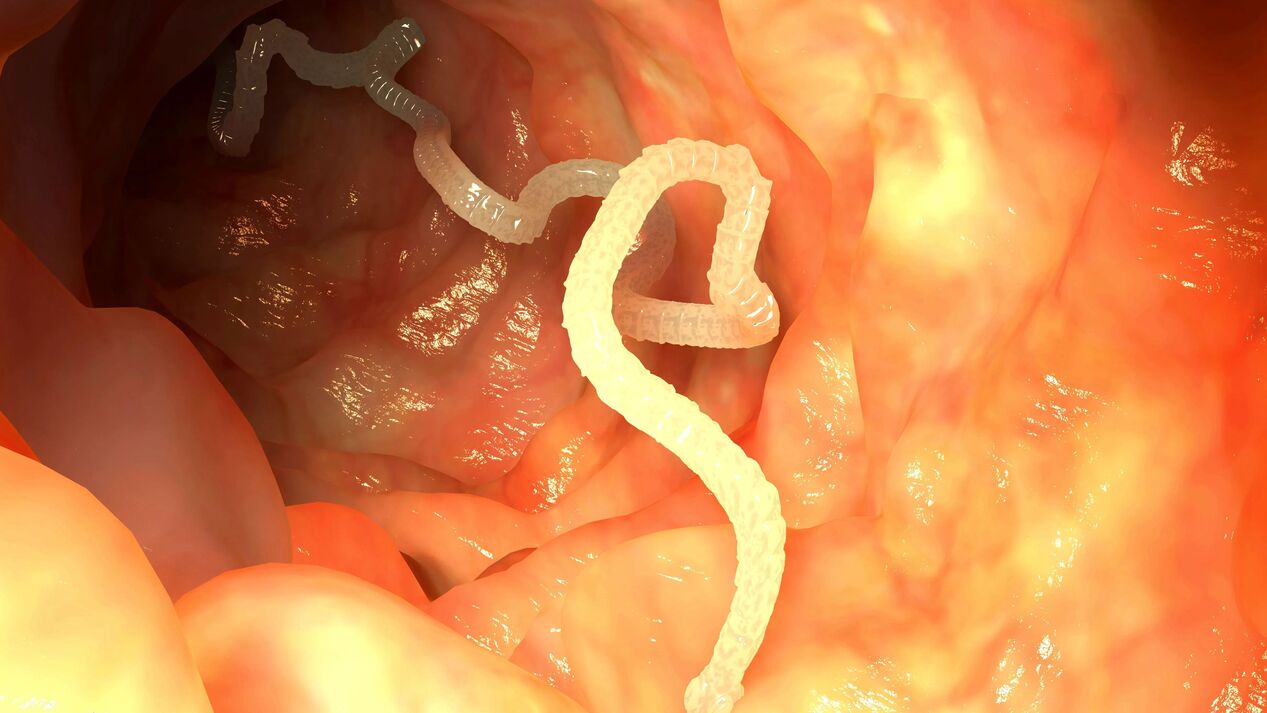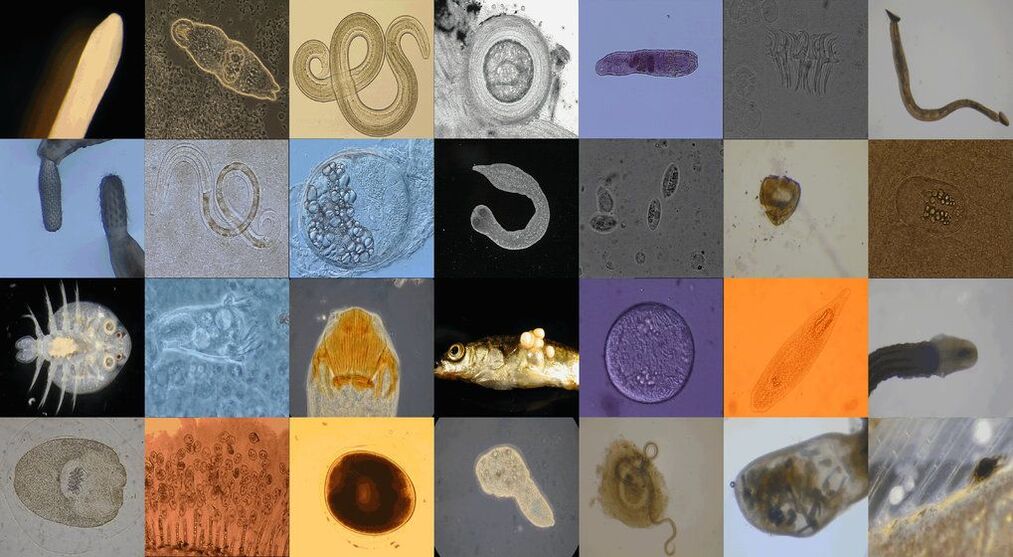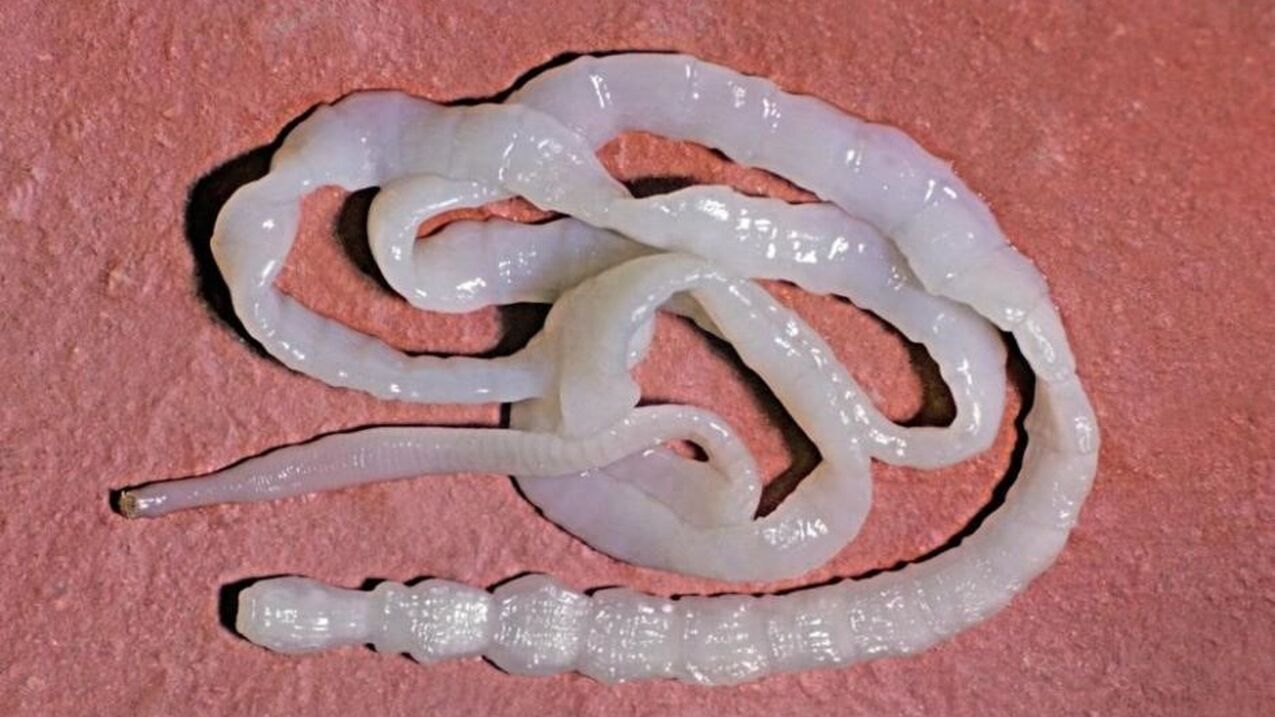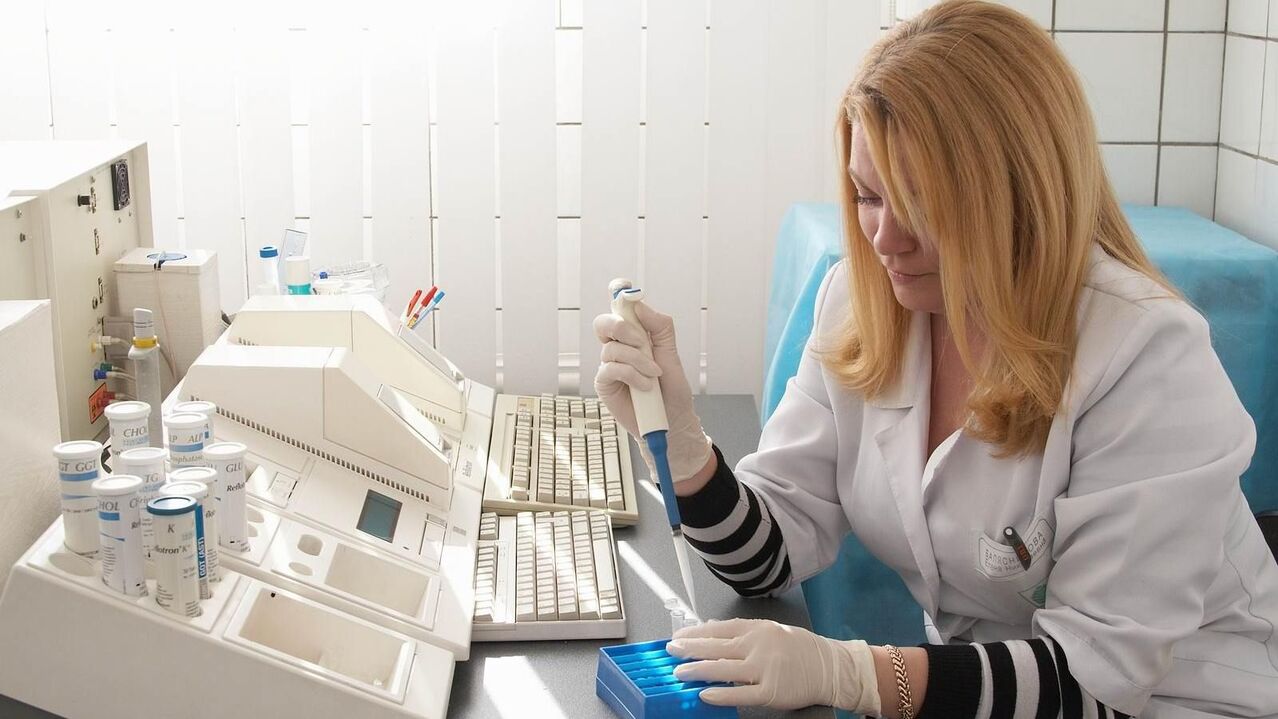
Worm infections usually cause considerable discomfort and health problems in a person. The symptoms of worms can be very different: fever, weakness, upset stomach, headache, etc.
Worms - what are they?

As we said above, adult worms traditionally have a stable localization in the body, and their developing forms often migrate to different organs and tissues, and often the path of their movement is quite complex. For example, with ascariasis, a person becomes infected by eating food contaminated with worm eggs (ascaris eggs ripen in the soil).
In the cavity of the intestinal tract, roundworm eggs hatch into larvae, which within a few hours enter through the wall of the intestinal tract into the blood vessels and are carried to the lungs through the bloodstream. In the lungs, roundworm larvae grow and mature. The growing larva slowly burrows into the adjacent bronchi and crawls along them, first into the trachea, and then into the oral cavity, where it is again swallowed and transported to the intestinal tract.
The roundworm larva that re-enters the intestinal tract transforms into an adult worm. Pulmonary migration of roundworm larvae is manifested by an abundance of symptoms (cough, asthma attacks, increased body temperature, allergic skin rash), and the presence of a small number of adult worms in the intestinal tract may not appear in anyway.
What are helminthiasis (helminthic diseases) - Symptoms of worms

The term "helminthiases" usually means a number of human diseases, the premise of which are various parasitic worms - helminths (another collective name for these parasites - worms).
Unlike diseases caused by bacteria, protozoa or fungi, with helminthiases, the number of helminths (worms) grown in the body of an infected person does not increase at one point (except in cases of re-infection). This is due to the fact that worms reproduce only outside the human body.
What are they?
Medicine recognizes more than a hundred types of helminths. Below are the most common types of worms:
- Pinworms are small worms in the human body that reach a length of 12 mm. This type of worm is diagnosed in the intestinal mucosa. Parasites enter the body with dust through the respiratory tract and can easily be transmitted from person to person.
- Roundworms are large round worms that are most commonly found in the small intestine. Infection of the body occurs through unwashed hands and food. Most often, roundworms are found in the body of children.
- Trichinella - these parasites have a round body no more than 5 mm in length and cause trichinosis in the body. Larvae and eggs prefer to be in lightly fried meat (pork, pig, bear). In the human body, Trichinella takes up to 4 days to become an adult and its life cycle is 40 days. The main purpose of this type of worm is to enter the bloodstream through the intestinal walls and settle in the muscles. In addition, the muscles of the respiratory and musculoskeletal systems are often affected.
- Pork/beef strip. The length of the parasite's body is 5-6 meters, and its larvae hide in the meat of large animals (pigs, cattle). The disease caused by these helminths is called taeniasis and taeniarhynchosis. The larvae of both types of tapeworms are white vesicles attached to the walls of the small intestine. The parasite takes 3 months to reach and form an adult, and the worm develops every day. The total number of segments reaches 2000, the final ones of which freely "groove" the large intestine. Then the worms leave the body together with feces through the anus. The most common and obvious symptom of helminthiasis is a damaged digestive tract, as well as the consumption of food in large quantities and the patient does not visually gain weight.
- Necator/hookworm. The connection between these parasites is direct, due to the diseases and biological characteristics they cause. They live in the duodenum, and due to their small size (10-15 mm) they move freely in its environment. Larvae can enter the body only through the skin if a person has been in contact with contaminated soil. The next target of the worms is the lungs along with the digestive tract. They feed only on the blood that comes out of the blood vessels of the bite. As a result of the powerful activity of these parasites, blood clotting is disrupted. Adults consume blood in the range of 0. 1-0. 35 ml per day.
- Echinococcus. In this case, a person acts as an intermediate host, because the final host is wolves, cats and dogs. Animals can become infected through direct contact with contaminated objects or people. As soon as the eggs of the parasite enter the intestine, larvae with six hooks, which in medicine are called oncospheres, immediately develop.
- Whipworms are diagnosed in a person's stomach. These are thin and quite large worms.
You can determine the type of helminths by looking at what color the worms are in the stool when they come out. Infection occurs through vegetables and meat that have undergone insufficient heat treatment. You can avoid infection by following food preparation rules.
How common and dangerous are worms?
Symptoms of worms. Data from modern epidemiological studies have revealed that every 4 people worldwide are infected with worms. The incidence of worm infection is significantly higher in children than in adults. In children and adults, worms can become a prerequisite for various acquired diseases of internal organs (gastritis, pancreatitis, enterocolitis, cholecystitis) and occasionally lead to the development of unsafe complications and death.
According to the World Health Organization and the Global Bank of Diseases, helminthic diseases rank 4th in terms of economic damage among all other diseases and injuries.
In our region, there are more than 15 types of worms, of which the most widespread are enterobiasis (about 90% in the group of patients with helminthic diseases), ascariasis (70%), opisthorciasis, diphyllobothriasis, trichocephalosis (60%), toxocariasis(60%), and hymenolepiase. As it becomes clear from the statistics, almost all patients (especially children) are simultaneously infected with some form of worms.
Where do worms spread to humans?
Many people believe that worms certainly live in the intestines, and for some types of helminths this is true. In general, worms can be found in a number of organs and systems of the human body:
- all kinds of tapeworms, whipworms and nematodes "settle" in the large intestine;
- trematodes attack the liver and gall bladder;
- Larvae of the pig worm can spread through the bloodstream to all organs - the subcutaneous fatty tissue, the eye chamber and blood vessels in the muscles can be affected.
How can you get infected with worms?
How do worms enter the human body? There are 4 main sources of helminth eggs that enter the body:
Geohelminthiasis- through soil (and then water) in which there are mature eggs of many helminths that enter the soil with human or animal feces, as well as through direct contact with animals and through the transfer of eggs from flies to food. Contact - from person to person Such well-known and more common worms as pinworms are transmitted; this is the highest risk of infection.
Biohelminthosis- when eating raw, semi-raw or slightly heat-treated meat (pork, beef) or fish infected with worms (sushi, kebab, dried fish, lard with meat streaks, etc. ) Some parasites enter the bodythrough insect bites
The main mechanism of any infection is most often oral-fecal, that is, a person simply swallows worm eggs along with food, water, and less often, some helminthic infections occur from the bites of infected insects. Undercooked meat and raw fish are understandable, but how can you get infected with worms through contact and contact with the house and through the soil?
Through the land
After any contact with soil or sand, you should not only wash your hands, but clean your nails thoroughly; it is best to keep the nails trimmed, especially for children. Food products that grow in the soil - vegetables, herbs, fruits, berries, mushrooms, everything connected to the soil requires thorough washing under running water and scalding with boiling water. Pets, mainly dogs and cats, walking on the street, bring a lot of sewage into the house, and children who play with them are at maximum risk of infection; the animal can easily infect him with any type of helminth. Flies are also the main carriers of helminths, being in public toilets, places where farm animals live, the flies then calmly land on the food, spreading the eggs on their wings and paws.
From person to person
With pinworms, infection of others occurs very easily. When a female worm crawls out of the intestines at night, she lays about 5, 000 eggs near the anus, which causes severe itching; the child, scratching the itchy area, infects their hands, nails, panties and sheets. Without washing his hands immediately, hundreds of eggs remain on all the objects he touches - doorknobs, clothes, food, toys. Further, the infection process is clear; eggs are also placed on the hands of a child or other adult using these items and without washing their hands before eating, they end up in the mouth of a healthy person.
Through the water
A large number of worm eggs end up in open water bodies and well water. Therefore, those who live in rural areas or in the country should use a bactericidal filter and be sure to boil the water; it is also dangerous to swallow water when swimming in open water.
Everyone knows that worms are mainly a problem for children. First, because they are more susceptible to the development of helminthiasis, since the protective barriers in children's bodies are not properly formed, and the acidity of the stomach is lower than in an adult. Secondly, children of preschool age, mastering the world, try all the surrounding objects not only with their hands, but also with taste. And parents, with all their desire, can teach their child to strictly observe the rules of personal hygiene, without reminders, only at the age of 3-6 years, which exposes not only the baby to danger, but also everyonefamily members. of infection (pinworms).
It should be remembered that no worm can breed and multiply in the human body, each species has its own period of time after which they die, for example, for pinworms it is only a few weeks, for roundworms it is about ayear. Eggs laid by adults must leave the body either in feces, or (in the case of worms) in the skin near the anus, in the external environment, in the soil, and only then, after they have matured outside the human body and re-enterin it. , they start to activate and parasitize.
Symptoms of worms

The development of helminthiasis usually occurs in two stages: acute - from two, three weeks to two months, and chronic - from several months to many years.
The acute phase coincides with the time of introduction and development of the parasite and is mainly manifested by an immune response to foreign antigens and allergic reactions. The symptoms of this stage of helminthiasis are similar when different types of parasites are introduced.
The chronic phase is distinguished by a great variety: depending on the location of the worms, their number and way of life, disturbances in the functioning of a number of organs and systems appear. By integrating into the metabolic system, consuming substances necessary for itself, the parasite leads to disturbances, manifested by disorders of digestion and absorption of vitamins, proteins, fats, carbohydrates and minerals. Worm waste products lead not only to the suppression of normal intestinal microflora, but also reduce immunity, promoting the development of chronic bacterial infections, reducing the effectiveness of preventive vaccinations.
The increased risk of malignant tumors is associated with a negative effect on the immune system and enhanced processes of cell division (regeneration) in damaged tissues.
The first signs of the development of helminthiasis can appear from 2-3 days (with ascariasis) to 1. 5 years (with filariasis). Most often this period is 2-3 weeks. At the beginning of the disease, skin rashes appear, enlargement of the lymph nodes, enlargement of the liver and spleen, pain in the muscles and joints. Some helminthiasis are characterized by specific signs, such as jaundice for opisthorchiasis (liver fluke) or fever, muscle pain, swelling of the face and eyelids for trichinosis.
In the chronic stage, the presence of single specimens of worms occurs practically without any symptoms, the exception may be the presence of large specimens, for example, tapeworms and roundworms. In the case of a more widespread infection, the symptoms of helminth infections consist of digestive disorders (nausea, bloating, abdominal pain, loose stools) and some specific signs. With enterobiasis, for example, this is itching in the anus, intensifying in the evening and at night.
With trichocephalosis is hemorrhagic colitis (with hemorrhage). With breast worm - iron deficiency anemia. With ascariasis, mechanical obstruction of the intestines and bile ducts can occur. With helminthiasis with liver damage, chronic hepatitis and inflammation of the biliary tract (cholecystitis, cholangitis) develop.
A special place is occupied by helminthiases with the development of cysts (liquid formations on the membrane): echinococcosis, alveococcosis, cysticercosis. Even large cysts may not appear in any way, but their suppuration or rupture brings serious consequences such as: anaphylactic shock, peritonitis, purulent pleurisy. Helminthiasis can be accompanied by symptoms of vegetative-vascular asthenia and neurotic states. Let's consider in more detail the most common special cases of helminthiasis.
Diagnosis of worms. Treatment of worms

With enterobiasis, the main condition for a successful treatment is the simultaneous removal of worms from all members of the family (or team of children), strict hygienic measures and repeated administration of drugs 10-14 days after the first one.
Folk remedies for the treatment of worms
Traditional treatment methods include medicinal plants that have anthelmintic and laxative effects. Even in ancient times, healers recommended the use of elecampane and celandine juice to expel worms. Carrots and carrot juice also have anthelmintic effects. Often in the recipes of traditional medicine you can find walnuts, pomegranate, mint and even more often - garlic in the form of a nutritional ingredient or enema. A decoction of wormwood is used in the form of enemas or orally. Pumpkin seeds are a well-known official remedy for worms. In folk medicine, the use of medicinal plants is often combined with saline laxatives. Although the effect of medicinal plants is not so high, they can serve as a prophylaxis or an addition to the traditional treatment of helminthiasis.
Complications of helminthiasis
Complications of helminthiasis are mainly associated with the mechanical effect of the parasite on the organ; tissue destruction sometimes leads to fatal dysfunction of the affected organ. The addition of bacterial infections at the sites of mechanical damage is a common complication that masks the presence of the parasite in the body. For impressionable people, the appearance of a parasite (for example, when expelled) can cause severe psychological trauma, requiring long-term rehabilitative treatment.
Prevention of worms
It includes timely identification and treatment of sick people and animals, compliance with personal hygiene measures (hand washing before eating, good washing of food products, painstaking heat treatment of food, especially meat and fish).
FAQ
What symptoms can indicate the presence of worms in a person?
Symptoms of worms can include constant fatigue, loss of appetite, weight loss, abdominal pain, itching in the anal area and digestive problems such as diarrhea or constipation.
How can you determine if a person has worms?
To determine the presence of worms in a person, you can perform a stool test for worm eggs or take a blood test for the presence of antibodies to worms. The doctor may also prescribe an ultrasound or other diagnostic procedures to confirm the diagnosis.
What precautions can be taken to prevent worm infections?
To prevent infection with worms, regular hand washing with soap and water is recommended, especially before eating and after using the toilet. You should also avoid contact with contaminated soil or water, drink only clean drinking water, and cook food properly to destroy any possible worm eggs.
Useful tips
Tip #1
Pay attention to changes in appetite and weight. If you or your child experiences constant hunger or, conversely, loss of appetite, this may be a sign of a helminthic infection.
Tip #2
Pay attention to the condition of your skin and hair. If you or your child has rashes, itching or changes in the texture of the hair (such as brittleness or hair loss), it may be due to the presence of worms.
Tip #3
Pay attention to the functioning of the gastrointestinal tract. If you or your child often experience colic, constipation or diarrhea, it may be due to a worm infection.



























